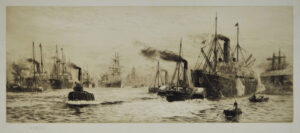 PS sent me a William Lionel Wyllie etching, “On the Clyde at Govan,” and wonders about the history of the theme. The image depicts toil, industry, grime, and beauty. We see the tugs on the teeming busy port at Clydeside, on the West Coast of Scotland in 1913. I say ‘toil’ for the beleaguered seamen who heaved the coal, ‘industry’ for the huge merchant steam cargo ships, ‘grime’ for the coal barges. I say ‘beauty,’ for the splendid two-masted sailing ships, or brigs, that sailed in 1913. And ‘teeming,’ because the estuary at Clyde was home to three important ports near Glasgow.
PS sent me a William Lionel Wyllie etching, “On the Clyde at Govan,” and wonders about the history of the theme. The image depicts toil, industry, grime, and beauty. We see the tugs on the teeming busy port at Clydeside, on the West Coast of Scotland in 1913. I say ‘toil’ for the beleaguered seamen who heaved the coal, ‘industry’ for the huge merchant steam cargo ships, ‘grime’ for the coal barges. I say ‘beauty,’ for the splendid two-masted sailing ships, or brigs, that sailed in 1913. And ‘teeming,’ because the estuary at Clyde was home to three important ports near Glasgow.
Brilliant Scottish engineers deepened the riverbed of the shallow River Clyde at Glasgow port. This allowed for international trade, the development of shipbuilding and the steam engine. Trade indeed become internatio the shipbuilding the finest, and the workers some of the most skilled. Many considered Govan a huge ‘feeder’ community for the port of 60,000 inhabitants in the late 19th century, although not an “upscale” place in the least.
The artist of this etching
William Lionel Wyllie (1851-1931), RA meaning a Royal Academician, loved the sea so much. He lived a large part of his productive life on a boat in the Lower Thames, and painted sea vessels from his perch. Plus he fathered nine children.
His work hangs at the Tate, the Royal Academy, The Imperial War Museum, The National Maritime Museum, and the National Museum of the Royal Navy. His talent won him the Turner Gold Medal prize at the age of 18. He sailed all his life, mainly in the company of his younger brother, also an artist.
A mural by Wyllie Blocking of the Zeebrugge Waterway, 1918 exhibited in 1920 for the Royal Exchange, London.
PS’s etching represents a kind of innovation in the history of maritime painting of the late 19th early 20th century. It pictures tugs working the barges in a silty sea with steam belching and men hauling. Artists tended to paint more glorious ships, not tugs, nor the Stumpies (barges with low masts), or ketches (two masted barges). We also see a hint of an early 20th century leisure craft, a two gunneled passenger steamer. This contrasts with how the wealthy toured the world in great luxury, especially in a stateroom “above” decks.
My son’s father, born not far from this location, calls Govan a sooty place, and one only imagines the fumes and smoke from the tugs and steamships in 1913. The world needed more and more coal, hauled on flat barges, and the “lighters” struggling under their loads of timber. Strong and skilled men manned the tugs and rowboats. In the etching we see them pushing the barges with oars, which also acted as rudders.
When Wyllie made this image, Govan, once an ancient Christian site became home of Fairfield’s Shipyard. Considered the largest in the world at the end of the 19th century, it employing 5000. In the two World Wars, Clydeside shipbuilding became vital. Clydeside was bombed in WWII because of its strategic role. Today few shipyards remain.
Wyllie famous in his day
At the age of 79, Wyllie mounted scaffolding to paint a forty-two foot panorama of the Battle of Trafalgar. King George V unveiled the painting in 1930 at the Royal Naval Museum in the Historic Dockyard at Portsmouth. Wyllie died a year later, and they buried him with full Naval honors in a procession at sea, in the style, says his bio, of Lord Horatio Nelson.
A maritime artist must be more than talented, he also must understand the technical aspects of sea-faring vessels, tides, currents, wind, and climate. He also needs to understand the men of the sea, and how they commandeered their ships. What makes this etching so interesting is the variety of working boats in the image, as well as the skillful portrayal of ships appearing to float in water, as well as the “feeling” derived from the image of the industrial nature of trade at Clydeside in the early 20th century. My son’s father tells me his great grandfather was likely part of this very scene, and he owns a pocket watch to prove it. The value is $1,000.
Pingback: William Lionel Wyllie Leading Maritime Artist - Elizabeth Appraisals